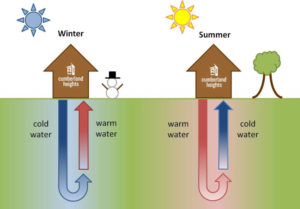Original Article By: Joanna Sammer
 When Nashville-based Cumberland Heights had to address an aging infrastructure for heating, ventilation and air conditioning (HVAC) on its 11-building campus, it chose a geothermal system. The organization’s experience offers insight into how behavioral healthcare organizations can evaluate and manage the installation of such a system, which arguably has a much greater impact on patient and staff comfort than many realize.
When Nashville-based Cumberland Heights had to address an aging infrastructure for heating, ventilation and air conditioning (HVAC) on its 11-building campus, it chose a geothermal system. The organization’s experience offers insight into how behavioral healthcare organizations can evaluate and manage the installation of such a system, which arguably has a much greater impact on patient and staff comfort than many realize.
Cumberland Heights opted for geothermal HVAC largely because of its energy efficiency and effectiveness. The system is designed to pay for itself within seven to 10 years through lower energy costs. Based on trends the facility has experienced since the system went online in May 2017, the system will achieve that projection, according to Butch Glover, the organization’s chief operations officer.
Geothermal systems heat and cool interior spaces by taking advantage of the consistent temperatures underground that range between 50 and 60 degrees Fahrenheit year round, which allows these systems to heat and cool using less energy with more efficiency than conventional heating systems. The systems take advantage of the fact that underground temperatures tend to be warmer in the winter and cooler in the summer than the air above ground. Air and water within the system are easier to heat or cool as they circulate underground then are forced out to heat and cool buildings.
Cumberland Heights, like many treatment centers residing in older buildings, wanted to replace its old HVAC systems largely due to the cost of maintaining them. In addition to creating a more energy efficient system, Glover says that the geothermal system has improved the air quality and humidity levels throughout the buildings. Since the system began running in May, “you can feel the difference the in air quality and that gives patients a more comfortable environment,” says Glover.
Preparation is key
The installation of a geothermal HVAC system is a complicated process that can impact many areas of patient care and operations.
1. Prepare staff and patients for the disruption.
Geothermal systems reside underground and take time to install and test. Therefore, behavioral healthcare organizations must be prepared for a lot of digging on site as the installation team puts in the required wells, which can be numerous. For example, Cumberland Heights’ system has 93 wells.
“We didn’t realize how much disruption the work would cause to the campus until it started,” says Russ Taylor, director of support services. “It’s important to remember that there is a lot of mud, noise and machinery that will disrupt normal walking routes and how people get around the campus.”
2. Work with the contractor on scheduling.
While there is no way to avoid some disruption, Glover and Taylor took steps to get everything back to normal as soon as the work was completed at each site. This involved everything from cleaning up to replacing the landscaping that had been removed. They recommend working closely with the contractor to discuss the schedule of work coming up so that staff has ample notice in case they needed to prepare patients for any disruption and move group sessions and meetings to less noisy and more accessible locations.
In addition, behavioral healthcare organizations must prepare the contractors for working in a behavioral healthcare environment. For example, the project had to be managed to ensure that there was no downtime and the campus could operate as normally as possible 24/7.
“The contractors had to keep us in business and realize that we can’t shut anything down,” says Glover. In many cases, that meant that the contractor had to be open to weekend and nighttime work as needed.
3. Ensure the contractor understands confidentiality.
Contractors and subcontractors also had to know how to interact with staff and patients and to understand the need for confidentiality. For example, workers on the project had to be clearly and easily identified. Likewise, workers had to understand how patients might behave if they interacted and how the workers should handle those interactions if they occurred.
4. Work with an architecture or engineering firm to manage the overall project.
An engineering firm can also make sure the work is occurring to specifications. The process for Cumberland Heights also included conditioning and testing the system three times—this past summer, during the coming winter and again next summer—to ensure that the system is working as expected.











